A 50th ANNIVERSARY spotlight on There’s No Hope in Crime Alley! from THE DENNY O’NEIL INTERVIEWS…
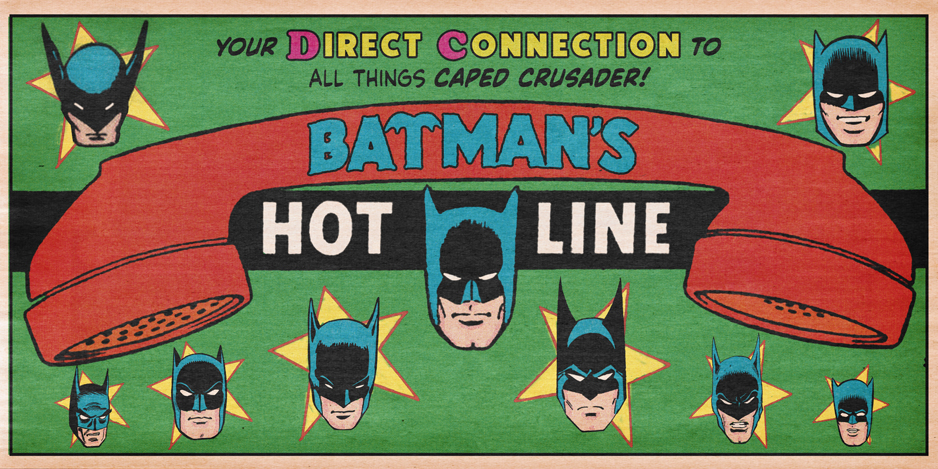
—
UPDATED 12/30/25: It’s the 50th anniversary of the late Denny O’Neil and Dick Giordano’s seminal There Is No Hope in Crime Alley!, from 1975’s Detective Comics #457. Perfect time to reprint this installment of THE DENNY O’NEIL INTERVIEWS from Aug. 12, 2014. Also, check out Jim Beard’s unique take on the classic story here. Dig it. — Dan
—
As Denny O’Neil and I sat in his suburban New York home talking Batman and his career, our discussion inevitably led to one of his tightest, yet most influential stories: The 12-page “There is No Hope in Crime Alley!” from Detective Comics #457, cover-dated March 1976 and illustrated by Dick Giordano.
(And if you missed them, go back and read our talks about Batman #251 and the Joker; Detective Comics #395 and making Batman dark again; and the origin of Ra’s al Ghul!)
—
This topic started with a discussion about his approach to writing Batman and how he viewed him in his mind:
Dan Greenfield: So Robin had left (for college, in Batman #217) and you were writing a Batman that was back to being more or less a solo character. …
Denny O’Neil: … I write scripts and on Thursday mornings I took them in to (editor) Julie (Schwartz)’s office and he gave me another assignment. I didn’t know until (former DC president) Paul (Levitz) told me about five years ago that “The Secret of the Waiting Graves” was considered to be important. I guess I knew it was a good story and I guess it accomplished what I wanted it to accomplish in the larger picture which is the same thing I wanted to accomplish years later when I became editor, which is to tell the readers, “This is not your father’s Batman.”
We were starting something new. Not radically new. We didn’t give him a red costume — the original Batman (had) a red costume and a domino mask. But the tone, the tenet, the kinds of stories we tell. The left field wall of the ballpark was changed a little bit. No more science-fiction … bad time-travel stories, bad alien stories. …
And I decided to — rat bastard that I am — take away Batman’s love life. Because I couldn’t make the character work in my head as someone who had a normal life. In my private, interior-skull biography, he’s a perpetual 33. That’s maybe my Catholic background coming out. That’s when the Lord went on.
Logically, he’s got about three more years and then one of two things happens: He misses a step on one of those rooftops and he gets killed, like a professional athlete, a fighter who stays in the game too long — Muhammad Ali — OR … he comes to his senses, seeks out Talia, they have the two most beautiful and intelligent children in the world and he uses his skills to get clean water for Africa, to help benefit humanity in other ways. That’s what I would wish for.
If I were writing this story, with no constraints, I’d probably opt for the grimmer attitude because the poor bastard is obviously obsessed. One of my influences was an essay that Alfred Bester, the great science-fiction writer who started as a comics writer — he was a friend of Julie’ s—wrote.
I belonged to the Science Fiction Writers of America for a while and they’d send out a magazine about four times a year with somebody talking about professional stuff. I loved Bester’s novels and here was this essay he wrote about the benefits of writing obsessed characters.
His character, Gully Foyle, in The Stars My Destination is maybe American literature’s most obsessed guy! That’s one of the reasons it makes a fascinating story. And everything that Alfie was saying, I thought, “Yeah! That’s Batman!” That was like turning the lens and bringing everything into focus. Of course! That’s what he IS!
Which means you probably wouldn’t want to hang around with him but you would want him walking behind you if you’re walking through certain parts of Brooklyn at 3 a.m.
But he would be obsessed so that’s when I decided that Batman is the REAL guy and Bruce Wayne is the disguise. Other people have played it other ways perfectly validly. There is NO one right way to act Hamlet. And there’s no one way to write Batman … or Superman! These characters have been around for … well, Superman’s 76 years, Batman’s 75, and it’s been estimated that 80 percent of the people on Earth know about Batman in one form or another. They are open to interpretation. Some interpretations I like better than I do others.
In my own interpretations, I’ve always pulled back short of taking them into areas where I don’t think a hero belongs.
Dan: Such as?
Denny: Um… Excessive violence. (Joking:) Let me be erudite once again. Buddha said if you have to kill, you need to kill, you kill to save your life, someone else’s life. Life is suffering is first-grade truth. This is sometimes unavoidable but you can not like it!
So this is the way I played Batman and that’s one of the reasons we introduced Leslie Tompkins, as a voice …
Dan: Here we go. A good segue because there’s the… (and I held up a copy of Detective #457)
Denny: Oh, there she is!
Dan: “No Hope in Crime Alley.”
Denny: Oh! Yeah! A brilliant job by Dick!
Well, Leslie was created, for one, to fill a hole in the continuity. OK, we know, depending on which comic book you read, by 8 or 10 years old, this kid is suddenly an orphan. But a very rich orphan. Still, he would need somebody! So I invented Leslie. She’s named after Tompkins Square Park in the East Village.
Dan: Oh, no kidding? That’s awesome! That’s great to know!
Den: My first bunch of years in New York I was living only a block or two or three from (there).
(He then explained that his first wife had been a Catholic Worker.)
The Catholic Worker was a group started by Dorothy Day and a guy named Peter Warren in 1939. Dorothy was an extraordinary woman. By reputation, she was the only woman in the village who could drink Eugene O’Neill under the table.
… She published what was for the time a very naughty novel (The Eleventh Virgin, 1924). She was always an activist. It depends on who you talk to but she became, either by conviction or because it furthered her activism — toss a coin, I don’t know which version is right — but she started the Catholic Worker with Peter Warren who was a kind of street philosopher.
And Dorothy’s credo was, “Render unto Caesar the things that are Caesar’s and unto God the things that are God’s … and, by the way, Caesar doesn’t deserve anything.” So she was getting arrested during World War II and especially during the ‘50s for not obeying the air raid sirens. She walked down the middle of Fifth Avenue. That did NOT make her popular with the conservative Catholic hierarchy.
The other thing she did and it continues to be done in her name was to shelter the homeless, clothe the naked, feed the hungry. My first wedding was at The Catholic Worker headquarters on Chrystie Street on the Lower East Side. So it’s very hard if you’re an archbishop to knock somebody who is out putting her life on the line every day.
Then they started a farm up across the river from Bard College which is where drunks could go to dry out. Dorothy was tough. She was the godmother of one of my oldest friends. She was an extraordinary woman.
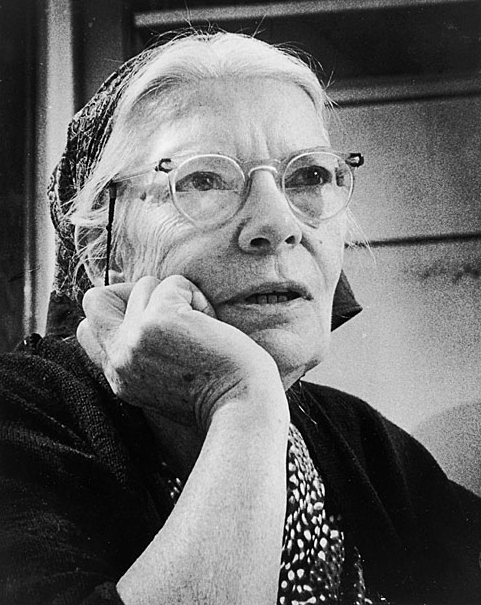
Dorothy Day
OK, Leslie has this in common with Dorothy. She is a pacifist. She is a total pacifist and she could be working on Gotham’s equivalent of Park Avenue. She chooses to stay in the ghetto because that’s where she can do the most good.
So I thought she was a very interesting character in her own right but more than that I wanted to get that voice in the mythos, that point of view.
And her attitude toward Bruce is, “You don’t have to do the violence. You’re basically a good man but you don’t need this.” And he can’t function without it. He does not enjoy hitting people but he’s limited in that in his own head, he doesn’t have an alternative sometimes.
Another private thing I never put into the stories is that Bruce Wayne spends a lot of time on computers solving crimes the way the British BBC Sherlock Holmes will casually solve a crime — toss off the solution to something while he’s working on something else. I think that once or twice a week, Gordon gets an email that says, “If you check into the pawn shop, you’ll find that that’s where the murderer is.”
So what we get is only those times like Kwai Chang Caine in the old Kung Fu series where he absolutely has no choice but to engage in violence. Like Kwai Chang Caine — I think I was writing Batman before I saw Kung-Fu, so I’m safe on that — he does not do it joyfully. It is not, “Oh, boy! It’s clobbering time.” It’s the way a surgeon had to cut open my chest and make a big mess and cause me three months of ache.
That’s Batman and violence.
—
MORE
— The Complete DENNY O’NEIL INTERVIEWS INDEX. Click here.
— BATMAN — THERE’S NO HOPE IN CRIME ALLEY: The MUSICAL. Click here.

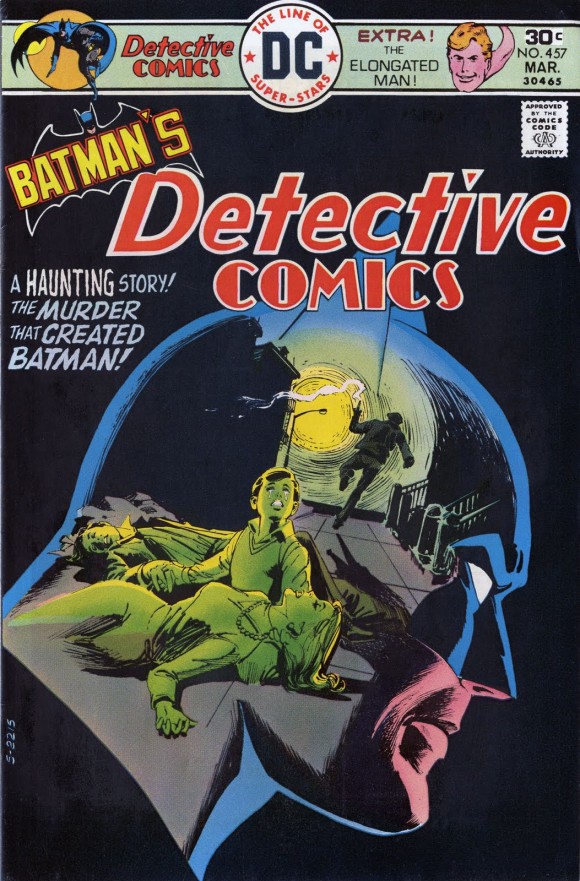
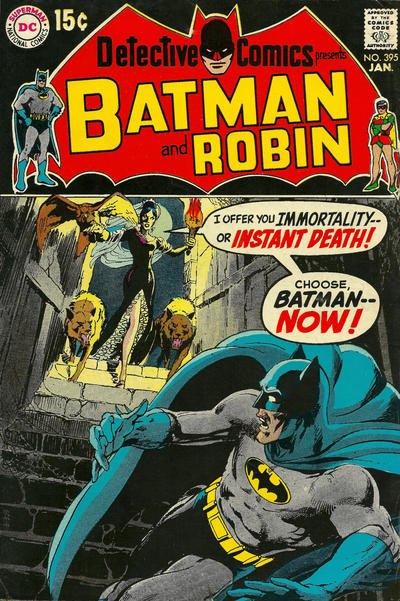
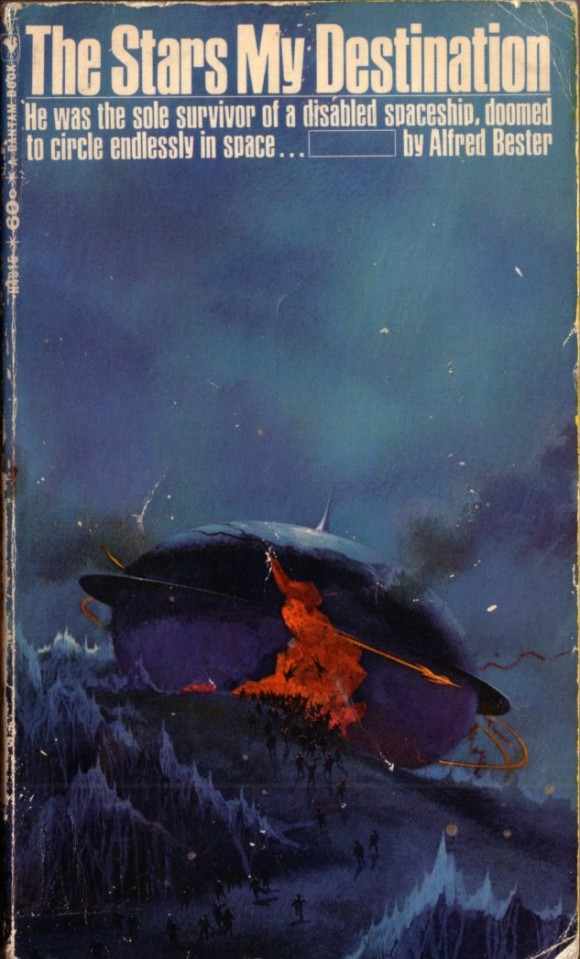
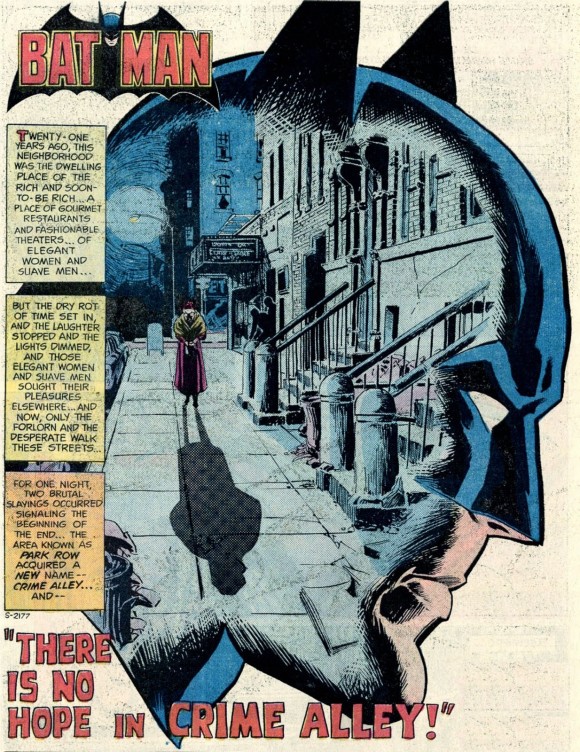
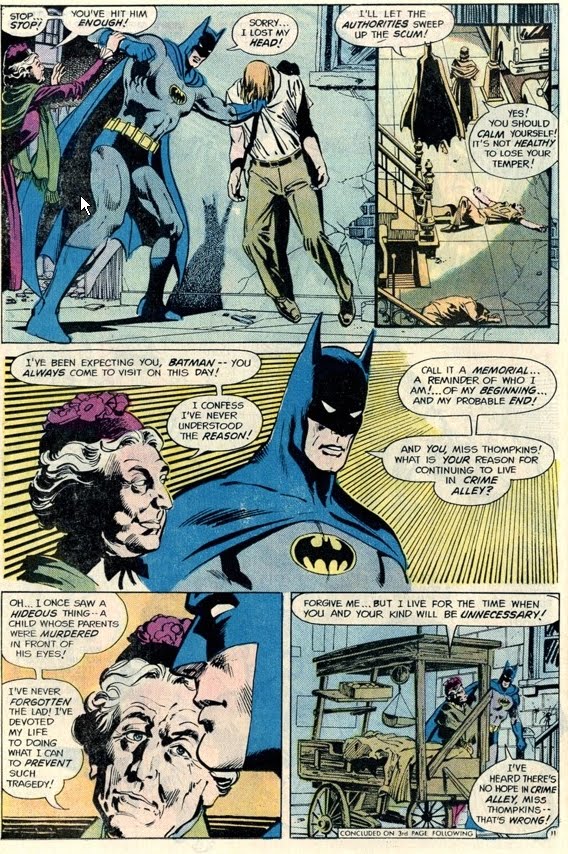
August 13, 2014
Enjoyed the interview. A few corrections: Dorothy Day and Peter Maurin founded the CW in 1933. She wasn’t arrested during World War II. And her reputation, according to Malcolm Cowley, was for drinking gangsters under the table..
September 19, 2019
Looking in advance for things to post on Facebook for this weekend’s Batman Day and I thought of “There Is No Hope in Crime Alley” as sort of an outliner story for non-comic book fans I could suggest. A search lead me to this article, which is GREAT! So much I never knew revealed by O’Neil. I’ll be sharing it on Saturday. Thanks!
December 30, 2025
I remember this. It may have been one of the comics I got in my Christmas stocking that year. Yes, a High School kid can have a Christmas stocking as long as he hints to “Santa” what to bring! A magnificent story, well-told.
December 30, 2025
What a fabulous insight into Denny’s Batman, I especially like the idea of Batman casually solving crimes by computer.
‘There is no hope in Crime Alley’ felt like an instant classic when it came out, I really wish Leslie had never appeared again, DC should have let her role in Batman’s life remain undiluted. My Lord, what they did with her name in the New 52…